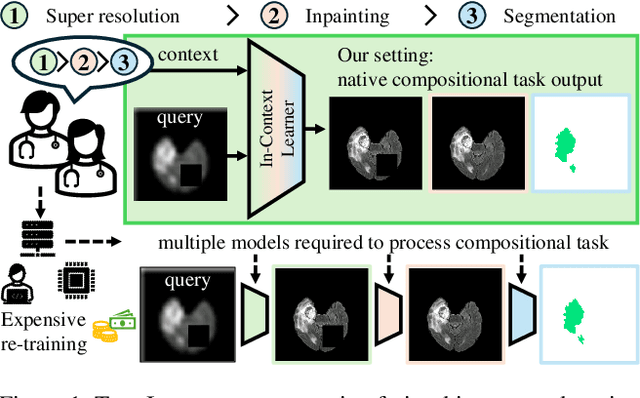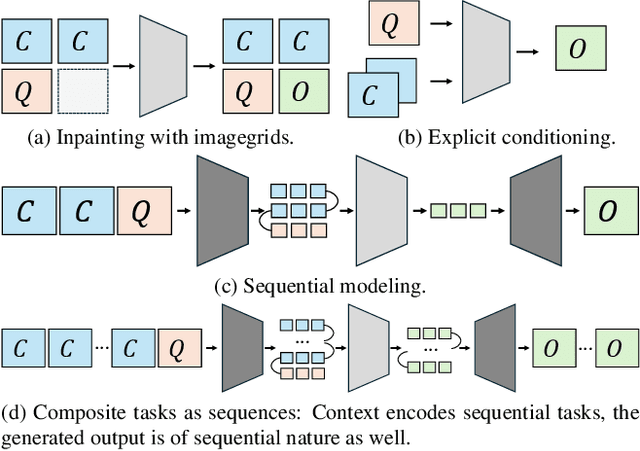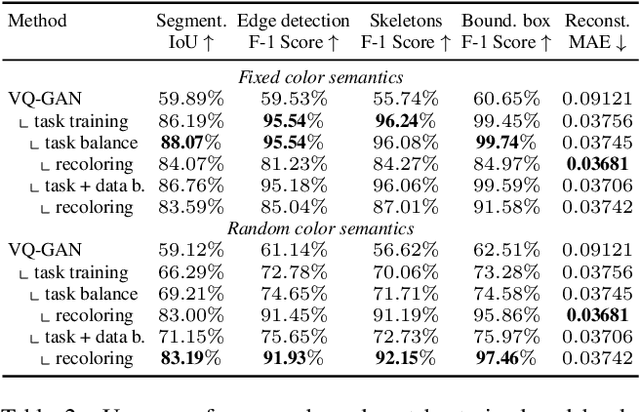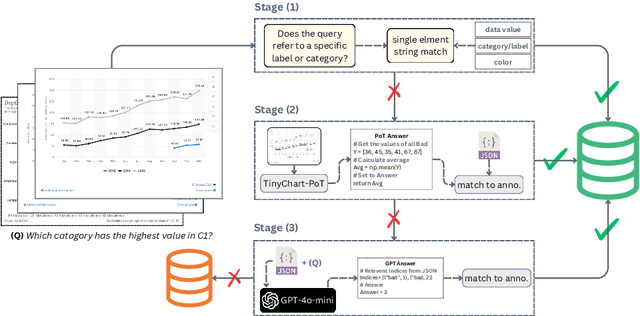Rainer Stiefelhagen
EReLiFM: Evidential Reliability-Aware Residual Flow Meta-Learning for Open-Set Domain Generalization under Noisy Labels
Oct 14, 2025



Abstract:Open-Set Domain Generalization (OSDG) aims to enable deep learning models to recognize unseen categories in new domains, which is crucial for real-world applications. Label noise hinders open-set domain generalization by corrupting source-domain knowledge, making it harder to recognize known classes and reject unseen ones. While existing methods address OSDG under Noisy Labels (OSDG-NL) using hyperbolic prototype-guided meta-learning, they struggle to bridge domain gaps, especially with limited clean labeled data. In this paper, we propose Evidential Reliability-Aware Residual Flow Meta-Learning (EReLiFM). We first introduce an unsupervised two-stage evidential loss clustering method to promote label reliability awareness. Then, we propose a residual flow matching mechanism that models structured domain- and category-conditioned residuals, enabling diverse and uncertainty-aware transfer paths beyond interpolation-based augmentation. During this meta-learning process, the model is optimized such that the update direction on the clean set maximizes the loss decrease on the noisy set, using pseudo labels derived from the most confident predicted class for supervision. Experimental results show that EReLiFM outperforms existing methods on OSDG-NL, achieving state-of-the-art performance. The source code is available at https://github.com/KPeng9510/ERELIFM.
MICA: Multi-Agent Industrial Coordination Assistant
Sep 17, 2025Abstract:Industrial workflows demand adaptive and trustworthy assistance that can operate under limited computing, connectivity, and strict privacy constraints. In this work, we present MICA (Multi-Agent Industrial Coordination Assistant), a perception-grounded and speech-interactive system that delivers real-time guidance for assembly, troubleshooting, part queries, and maintenance. MICA coordinates five role-specialized language agents, audited by a safety checker, to ensure accurate and compliant support. To achieve robust step understanding, we introduce Adaptive Step Fusion (ASF), which dynamically blends expert reasoning with online adaptation from natural speech feedback. Furthermore, we establish a new multi-agent coordination benchmark across representative task categories and propose evaluation metrics tailored to industrial assistance, enabling systematic comparison of different coordination topologies. Our experiments demonstrate that MICA consistently improves task success, reliability, and responsiveness over baseline structures, while remaining deployable on practical offline hardware. Together, these contributions highlight MICA as a step toward deployable, privacy-preserving multi-agent assistants for dynamic factory environments. The source code will be made publicly available at https://github.com/Kratos-Wen/MICA.
Semantic Segmentation for Preoperative Planning in Transcatheter Aortic Valve Replacement
Jul 22, 2025Abstract:When preoperative planning for surgeries is conducted on the basis of medical images, artificial intelligence methods can support medical doctors during assessment. In this work, we consider medical guidelines for preoperative planning of the transcatheter aortic valve replacement (TAVR) and identify tasks, that may be supported via semantic segmentation models by making relevant anatomical structures measurable in computed tomography scans. We first derive fine-grained TAVR-relevant pseudo-labels from coarse-grained anatomical information, in order to train segmentation models and quantify how well they are able to find these structures in the scans. Furthermore, we propose an adaptation to the loss function in training these segmentation models and through this achieve a +1.27% Dice increase in performance. Our fine-grained TAVR-relevant pseudo-labels and the computed tomography scans we build upon are available at https://doi.org/10.5281/zenodo.16274176.
Is Visual in-Context Learning for Compositional Medical Tasks within Reach?
Jul 02, 2025



Abstract:In this paper, we explore the potential of visual in-context learning to enable a single model to handle multiple tasks and adapt to new tasks during test time without re-training. Unlike previous approaches, our focus is on training in-context learners to adapt to sequences of tasks, rather than individual tasks. Our goal is to solve complex tasks that involve multiple intermediate steps using a single model, allowing users to define entire vision pipelines flexibly at test time. To achieve this, we first examine the properties and limitations of visual in-context learning architectures, with a particular focus on the role of codebooks. We then introduce a novel method for training in-context learners using a synthetic compositional task generation engine. This engine bootstraps task sequences from arbitrary segmentation datasets, enabling the training of visual in-context learners for compositional tasks. Additionally, we investigate different masking-based training objectives to gather insights into how to train models better for solving complex, compositional tasks. Our exploration not only provides important insights especially for multi-modal medical task sequences but also highlights challenges that need to be addressed.
HopaDIFF: Holistic-Partial Aware Fourier Conditioned Diffusion for Referring Human Action Segmentation in Multi-Person Scenarios
Jun 11, 2025Abstract:Action segmentation is a core challenge in high-level video understanding, aiming to partition untrimmed videos into segments and assign each a label from a predefined action set. Existing methods primarily address single-person activities with fixed action sequences, overlooking multi-person scenarios. In this work, we pioneer textual reference-guided human action segmentation in multi-person settings, where a textual description specifies the target person for segmentation. We introduce the first dataset for Referring Human Action Segmentation, i.e., RHAS133, built from 133 movies and annotated with 137 fine-grained actions with 33h video data, together with textual descriptions for this new task. Benchmarking existing action recognition methods on RHAS133 using VLM-based feature extractors reveals limited performance and poor aggregation of visual cues for the target person. To address this, we propose a holistic-partial aware Fourier-conditioned diffusion framework, i.e., HopaDIFF, leveraging a novel cross-input gate attentional xLSTM to enhance holistic-partial long-range reasoning and a novel Fourier condition to introduce more fine-grained control to improve the action segmentation generation. HopaDIFF achieves state-of-the-art results on RHAS133 in diverse evaluation settings. The code is available at https://github.com/KPeng9510/HopaDIFF.git.
Good Enough: Is it Worth Improving your Label Quality?
May 27, 2025



Abstract:Improving label quality in medical image segmentation is costly, but its benefits remain unclear. We systematically evaluate its impact using multiple pseudo-labeled versions of CT datasets, generated by models like nnU-Net, TotalSegmentator, and MedSAM. Our results show that while higher-quality labels improve in-domain performance, gains remain unclear if below a small threshold. For pre-training, label quality has minimal impact, suggesting that models rather transfer general concepts than detailed annotations. These findings provide guidance on when improving label quality is worth the effort.
OmniFall: A Unified Staged-to-Wild Benchmark for Human Fall Detection
May 26, 2025Abstract:Current video-based fall detection research mostly relies on small, staged datasets with significant domain biases concerning background, lighting, and camera setup resulting in unknown real-world performance. We introduce OmniFall, unifying eight public fall detection datasets (roughly 14 h of recordings, roughly 42 h of multiview data, 101 subjects, 29 camera views) under a consistent ten-class taxonomy with standardized evaluation protocols. Our benchmark provides complete video segmentation labels and enables fair cross-dataset comparison previously impossible with incompatible annotation schemes. For real-world evaluation we curate OOPS-Fall from genuine accident videos and establish a staged-to-wild protocol measuring generalization from controlled to uncontrolled environments. Experiments with frozen pre-trained backbones such as I3D or VideoMAE reveal significant performance gaps between in-distribution and in-the-wild scenarios, highlighting critical challenges in developing robust fall detection systems. OmniFall Dataset at https://huggingface.co/datasets/simplexsigil2/omnifall , Code at https://github.com/simplexsigil/omnifall-experiments
CHAOS: Chart Analysis with Outlier Samples
May 22, 2025Abstract:Charts play a critical role in data analysis and visualization, yet real-world applications often present charts with challenging or noisy features. However, "outlier charts" pose a substantial challenge even for Multimodal Large Language Models (MLLMs), which can struggle to interpret perturbed charts. In this work, we introduce CHAOS (CHart Analysis with Outlier Samples), a robustness benchmark to systematically evaluate MLLMs against chart perturbations. CHAOS encompasses five types of textual and ten types of visual perturbations, each presented at three levels of severity (easy, mid, hard) inspired by the study result of human evaluation. The benchmark includes 13 state-of-the-art MLLMs divided into three groups (i.e., general-, document-, and chart-specific models) according to the training scope and data. Comprehensive analysis involves two downstream tasks (ChartQA and Chart-to-Text). Extensive experiments and case studies highlight critical insights into robustness of models across chart perturbations, aiming to guide future research in chart understanding domain. Data and code are publicly available at: http://huggingface.co/datasets/omoured/CHAOS.
Exploring Video-Based Driver Activity Recognition under Noisy Labels
Apr 16, 2025Abstract:As an open research topic in the field of deep learning, learning with noisy labels has attracted much attention and grown rapidly over the past ten years. Learning with label noise is crucial for driver distraction behavior recognition, as real-world video data often contains mislabeled samples, impacting model reliability and performance. However, label noise learning is barely explored in the driver activity recognition field. In this paper, we propose the first label noise learning approach for the driver activity recognition task. Based on the cluster assumption, we initially enable the model to learn clustering-friendly low-dimensional representations from given videos and assign the resultant embeddings into clusters. We subsequently perform co-refinement within each cluster to smooth the classifier outputs. Furthermore, we propose a flexible sample selection strategy that combines two selection criteria without relying on any hyperparameters to filter clean samples from the training dataset. We also incorporate a self-adaptive parameter into the sample selection process to enforce balancing across classes. A comprehensive variety of experiments on the public Drive&Act dataset for all granularity levels demonstrates the superior performance of our method in comparison with other label-denoising methods derived from the image classification field. The source code is available at https://github.com/ilonafan/DAR-noisy-labels.
RefChartQA: Grounding Visual Answer on Chart Images through Instruction Tuning
Mar 29, 2025



Abstract:Recently, Vision Language Models (VLMs) have increasingly emphasized document visual grounding to achieve better human-computer interaction, accessibility, and detailed understanding. However, its application to visualizations such as charts remains under-explored due to the inherent complexity of interleaved visual-numerical relationships in chart images. Existing chart understanding methods primarily focus on answering questions without explicitly identifying the visual elements that support their predictions. To bridge this gap, we introduce RefChartQA, a novel benchmark that integrates Chart Question Answering (ChartQA) with visual grounding, enabling models to refer elements at multiple granularities within chart images. Furthermore, we conduct a comprehensive evaluation by instruction-tuning 5 state-of-the-art VLMs across different categories. Our experiments demonstrate that incorporating spatial awareness via grounding improves response accuracy by over 15%, reducing hallucinations, and improving model reliability. Additionally, we identify key factors influencing text-spatial alignment, such as architectural improvements in TinyChart, which leverages a token-merging module for enhanced feature fusion. Our dataset is open-sourced for community development and further advancements. All models and code will be publicly available at https://github.com/moured/RefChartQA.
 Add to Chrome
Add to Chrome Add to Firefox
Add to Firefox Add to Edge
Add to Edge